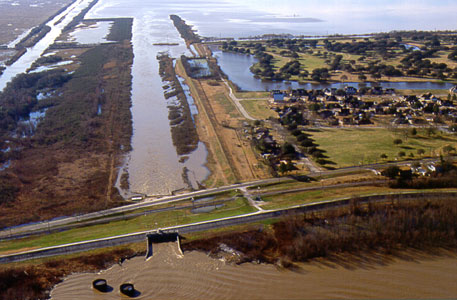Adverse Water Quality Conditions Could Threaten Oysters
In Breton Sound, two opposing forces are poised to meet. Coming from the north are Louisiana’s proposed river diversions. Moving up from the south is the ever-rising Gulf of Mexico. At the intersection of these two influences sits the important oyster.
The potential meeting of diversions and the Gulf creates unique conditions throughout the sound. River diversions carry freshwater and sediment from the Mississippi River. Gulf waters are much the opposite. So, what happens when the two meet?

The Caernarvon diversion inlet, located 15 miles downstream from New Orleans. Photo courtesy U.S. Army Corps of Engineers.
A group of scientists from the United States Geological Survey (USGS) and the Louisiana State University recently teamed up to tackle these water quality questions. Their publication in Estuaries and Coasts examines estuarine water quality conditions and compares changes under different scenarios of sea level rise and river diversion. The results were at times unexpected and provide needed information for resource managers.
When large diversions drive freshwater flows into Breton Sound, there is a dramatic reduction in salinity. The researchers found that large diversions have the ability to lower salinity by two-thirds – an amount that would be felt by most estuary species.
It seems logical to assume that the encroachment of the Gulf of Mexico would increase salinity, but not in Breton Sound. Surprisingly, salinity would decrease in the heart of the estuary despite increases in the head and toe. This indicates that something unique is at play.
“Diversions and sea level rise are critical driving forces to estuarine water quality,” says lead author Hongqing Wang of USGS. “We learned that their interactions are complicated. There is tremendous interplay between the elements in the estuary, resulting in salinity fluctuating greatly over space and time.
The researchers also examined water clarity and phytoplankton populations. Large diversions carry suspended sediments that make the water cloudier, while the rising Gulf added to the turbidity. Murkier waters limit the sunlight needed for photosynthesis, posing a challenge to phytoplankton and other aquatic vegetation
Within the sound, the greatest water quality fluctuations occurred in the middle section, which is prime oyster habitat. Louisiana oysters thrive in salinities between 5-15 parts per thousand (ppt). With large diversions, the salinity can drop below 4 ppt. Excess sediment and dwindling phytoplankton also were documented with diversions, equally bad news for oysters.
Large diversions have the power to significantly change the water quality throughout the sound. “Hydrology influences everything,” says Megan La Peyre of the USGS Louisiana Cooperative Fish and Wildlife Research Unit, LSU Agricultural Center. “Understanding these interactions is important for resource management.”
Oysters need somewhat salty, clear, chlorophyll-rich waters, supplied by the Gulf of Mexico. But they also need healthy wetland habitat, which could disappear without river diversions. This creates a complicated balancing act, one that will be repeated time and again. “Predicting the impacts of climate change in deltas is important both locally and globally,” says Wang. “Rivers feed into deltas all over the world.” And deltas help feed people all over the world.
